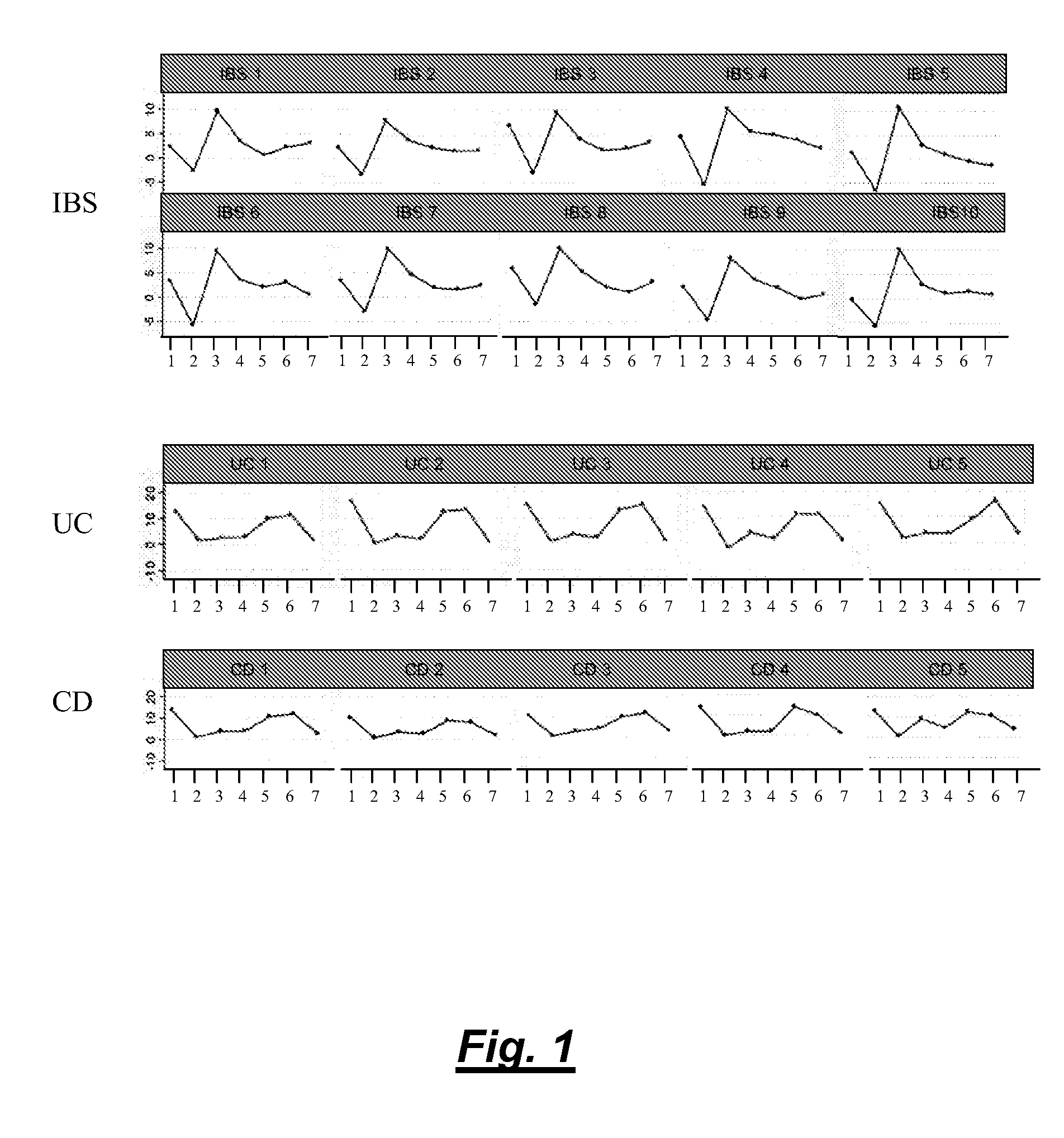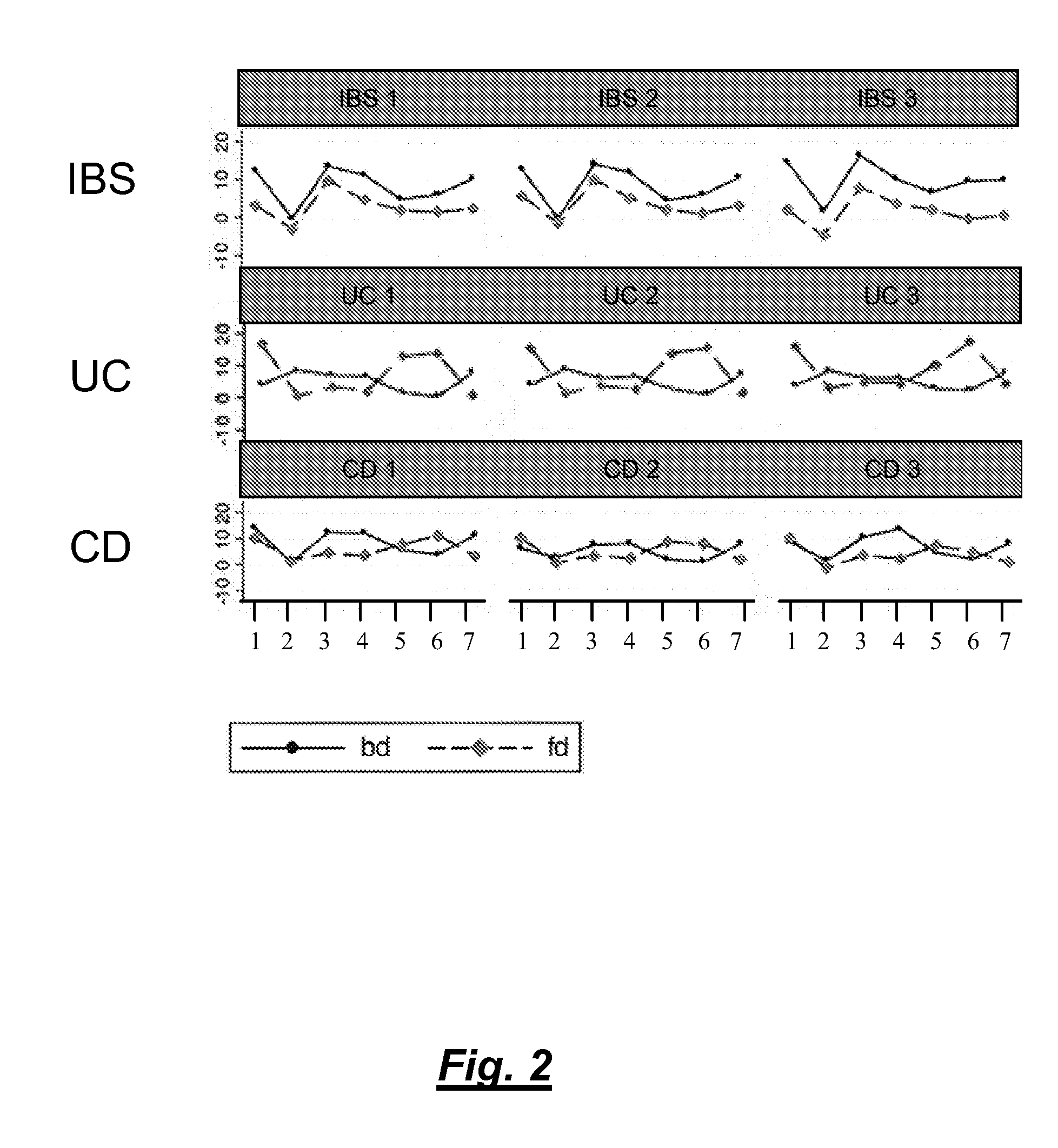Method and Kit for Use in the Differentiation of IBD and IBS and Further Distinction Between Disease Types of IBD
a technology of ibd and kit, which is applied in the field of method and kit for use in the differentiation of ibd and ibs and further distinction between the disease types of ibd, can solve the problems of poor definition of environmental risk factors for the development of ibd, considerable risk of colorectal cancer for patients with long-standing ibd, and considerable side effects, so as to achieve accurate, rapid and reliable screening.
- Summary
- Abstract
- Description
- Claims
- Application Information
AI Technical Summary
Benefits of technology
Problems solved by technology
Method used
Image
Examples
example 1
Tissue Collection and Storage
[0098]Colon tissue biopsies, faeces and blood samples were taken from patients suffering from UC, CD or IBS and from healthy volunteers.
[0099]1.1 For RNA Work:
[0100]Faeces samples were taken from patients suffering from UC, CD or IBS (5 to 10 patients each). The faeces samples were mixed in a 1:1 ratio with RNAlater® solution (Ambion Inc. / Applied Biosystems) and kept at RT until use.
[0101]1.2 For Protein Work:
[0102]Faeces samples were taken from patients suffering from UC, CD or IBS. The faces samples were directly frozen at −20° C. until use. Alternatively, the samples are mixed with appropriate buffer in a 1:1 ratio.
example 2
RNA Extraction from Faeces Samples for Real-Time PCR Analysis
[0103]2.1 RNA Isolation:
[0104]Total RNA from all patient faeces samples was isolated by first homogenizing the biopsies using a Pellet Pestle Motor Homogenizer according to the manufacturer's protocol (Kimble / Kontes, Kimble Glass Inc.). From the homogenate, total RNA was isolated using Qiagen RNeasy® Kit as according to manufactures guidelines (Qiagen Nordic AB).
[0105]2.2 cDNA Synthesis:
[0106]Two micrograms of each RNA sample was used for a first strand cDNA synthesis using 10 pM of the Oligo-dT-primer VN-T20 (5′-TTT TTT TTT TTT TTT TTT TTN V-3′). The buffer, deoxynucleotide triphosphates (dATP, dCTP, dGTP and dTTP) and the enzyme reverse transcriptase (Superscript II) were supplied by Invitrogen and the reactions were performed according to the manufactures guidelines. The reaction mixture for first strand synthesis excluding the enzyme was pre-incubated for 10 min at 65° C. in a PCR machine (PCR sprint from Hybaid), chil...
example 3
Protein Extraction
[0115]3.1 Protein Extraction from Biopsy Samples
[0116]The obtained fixed biopsy samples have to be centrifuged, the fixative removed and washed with PBS. Then extraction buffer (100 mM potassium phosphate pH 7.8; 1 mM DTT; 0.5 mM PMSF) was added and the sample homogenized using a Pellet Pestel Homogenizer according to the manufacturer's protocol. Then 0.1-0.2% of Triton-X-100 was added and the mixture incubated for 5 min at 4° C. to lyse the cells. After centrifugation of 5 min at 4° C. the supernatant (=extract) was transferred into a new tube and the extract stored after shock freezing at −80° C. until usage.
[0117]3.2 Protein Extraction from Faeces Samples
[0118]Extraction buffer (100mM potassium phosphate pH 7.8; 1 mM DTT; 0.5 mM PMSF) and glass beads were added to the faeces samples and thoroughly vortexed. Then 0.1-0.2% of Triton-X-100 was added and incubated for 5 min at 4° C. to lyse the cells. After centrifugation during 5 min at 4° C., the supernatant (=ext...
PUM
| Property | Measurement | Unit |
|---|---|---|
| concentrations | aaaaa | aaaaa |
| concentrations | aaaaa | aaaaa |
| concentrations | aaaaa | aaaaa |
Abstract
Description
Claims
Application Information
 Login to View More
Login to View More - R&D
- Intellectual Property
- Life Sciences
- Materials
- Tech Scout
- Unparalleled Data Quality
- Higher Quality Content
- 60% Fewer Hallucinations
Browse by: Latest US Patents, China's latest patents, Technical Efficacy Thesaurus, Application Domain, Technology Topic, Popular Technical Reports.
© 2025 PatSnap. All rights reserved.Legal|Privacy policy|Modern Slavery Act Transparency Statement|Sitemap|About US| Contact US: help@patsnap.com



